skip to main |
skip to sidebar
Events of Wednesday, 11th October 2017
In the morning my friend Ko Hlaing came to my hotel with Sandy, his 8-year old daughter. We travelled by a taxi he'd engaged to look at the unusual open-air market at Tha Ye Ze. Vegetable vendors were everywhere, squatting on the ground with their produce. I could just make out two parallel and apparently abandoned railway tracks running through the site, underneath the impromptu market stalls.
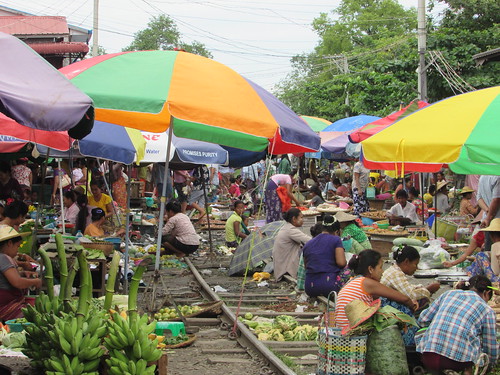
Tha Ye Ze (Madaya Line): The Market in full swing.
But, after about ten minutes, some of the traders reluctantly started to move their produce to one side, clearing a narrow pathway where the one set of rails lay. Looking down the track, I could see a 900 horse power diesel electric locomotive and its train slowly approaching.
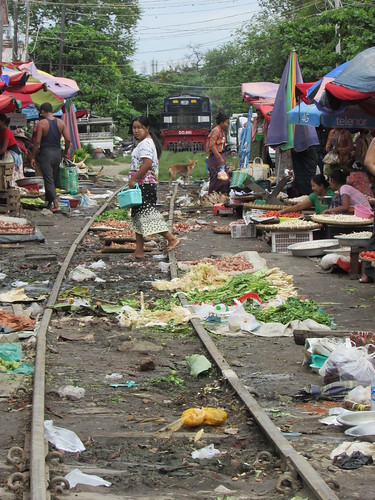
Tha Ye Ze (Madaya Line): With most of the produce removed from the line, DD.901 arrives with its train.
The train passed through the market and came to a halt a few yards further on at Tha Ye Ze station. The locomotive needed to run round its train, so the traders then had to clear the second line to let the locomotive pass and finally allow the locomotive to traverse the market a third time to couple onto its train ready for the next working. The market traders carried on selling their produce as if nothing had happened. I didn't discover the time of the next service to Madaya but, having shut down the diesel engine, the smiling Driver let me climb up and examine the cab.
This market visit was the key to my gaining an understanding of the history of Mandalay's 'Circle Line' railway, which I discuss in the post here.
Sandy wasn't too well that day so we drove to the family shop in 'The Street of the Marble Carvers' where we left her to relax.
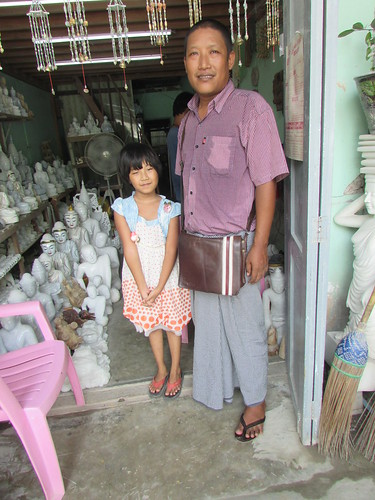
Sandy and Ko Hlaing.
Ko Hlaing and I continued by car to Myo Haung station on the main Mandalay - Yangon line. The rest of the day was spent in the signal cabin there, studying the equipment and working arrangements and, occasionally, making a few lever movements under supervision.
Train movements to the next Block Station are authorised by a Paper Line Clear Form, carried to the driver by a 'runner'.
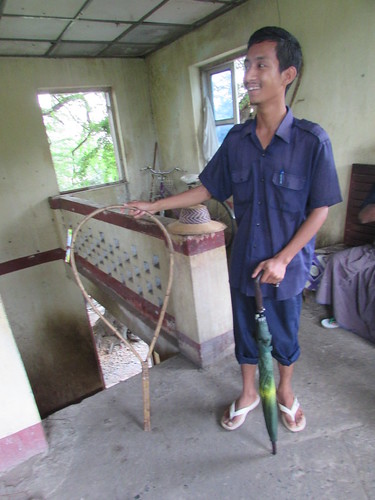
Myo Haung Signal Cabin: A railwayman displays the cane hoop with the vital rolled-up Paper Line Clear Form attached. This form is issued by the Controller and, when received by the driver, authorises the train's movement.
Myo Haung has an interlocked lever frame. All signals are searchlight or position-light types. Points are a mixture of electrically-operated and mechanically operated.
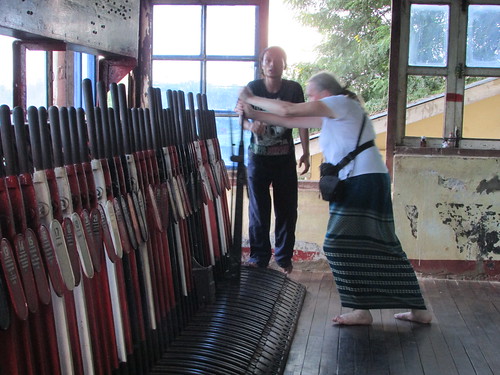
Myo Haung Signal Cabin: Jan replaces a point lever, watched by the signalman. Bare feet show respect for the location.
I was allowed to clear the signals for the afternoon express from Mandalay to Yangon - a new, Chinese-built Bo-Bo-Bo locomotive at the head of modern, Chinese-built coaches.
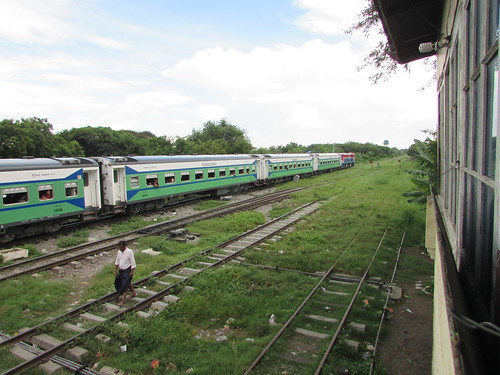
MR: Myo Haung Signal Cabin: The afternoon express from Mandalay to Yangon - Chinese-built locomotive and modern, Chinese-built coaches.
What a great experience! So, how do you follow that? The taxi took Ko Hlaing and me to Shwe Kyet Yet Jetty, where the 'Road to Mandalay' river cruise ship has private moorings and facilities for re-supplying the ship. The ship was moored against the bank so I was able to board using a rather smart gangway to find the Hotel Manager, Marie, waiting to greet me and introduce me to the ship's officers - the Captain, Doctor Hla Tun and the Chief Engineer. Although I'd not travelled on the ship for a number of years, there were many familiar, smiling faces so it was a very pleasant 'homecoming' for me. After settling into my comforable cabin, I enjoyed an excellent dinner with Doctor Hla Tun in the ship's spacious restaurant.
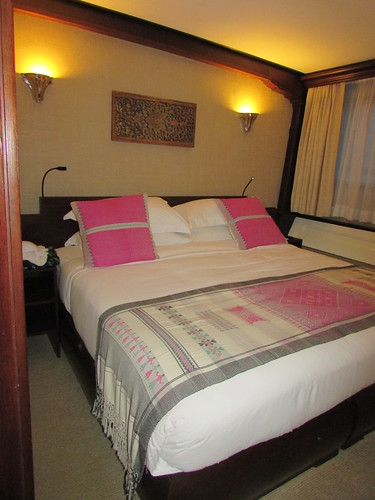
'Road to Mandalay', 2017.
Related posts on this website
This is one of a series of posts describing my 12th visit to Myanmar. The post Starting out is the first post in the series.
Clicking on the 'Next report' link displays the post describing the next events. In this way, you may read about the trip in sequence.
Next report.
Alternately, clicking on the 'All my Burma-2017(2) reports' link displays all the posts on this trip in reverse date-of-posting order.
All my Burma-2017(2) reports.
My photograph albums
Where necessary, clicking on an image above will display an 'uncropped' view or, alternately, pictures may be selected, viewed or downloaded, in various sizes, from the albums listed:-
Rupar Mandalar Hotel.
MR: Tha Ye Ze.
MR: Myo Haung Signal Cabin.
'Road to Mandalay': October 2017.
[Minor changes, pictures added 26-Oct-2017]
Events of Tuesday 10th October 2017
We'd arranged that my friend Htein Lin, his wife and two daughters would visit me at my hotel for a trip out. They arrived a little before 8.00 a.m. and we all sat on the Poolside Terrace at the hotel and enjoyed a simple breakfast together.
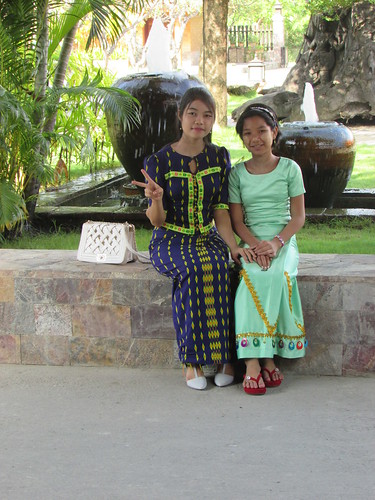
Htein Lin's Daughters at Rupar Mandalar Hotel.
Until recently, Htein Lin was a locomotive driver based at Mohnyin locomotive depot. We had first met in 2012 when he was the driver of the 'Road to Mandalay' special train from Katha to Naba. That day is described in the post here. Before becoming a driver, Htein Lin had followed his father in working at the Railway Workshops in Myitnge, a few miles south of Mandalay. Recently, he had accepted a supervisory position in the New Coach Construction Factory currently being built at Myitnge and, only a few days before our meeting, had brought his family and furniture back from Mohnyin to Myitnge where family members still live. At the same time, his elder daughter was about to start a degree course in Mathematics at Mandalay University.
So you may imagine that there were many things to talk about but, inevitably, railways in Britain and Myanmar featured heavily. Htein Lin had arranged for me to have a tour of the existing coach workshops at Myitnge and the new factory under construction which should open in 2018 so we had to break off to travel to Myitnge.
My friend had arranged the use of an official railway car (a RAV4) and driver so we climbed aboard and set off into Mandalay's heavy traffic. Being a railway vehicle, the windscreen bore an official 'sticker'. I realised the advantage that this conferred when we approached the modern road toll station south of the city, for we passed through unmolested. I've enjoyed the same happy experience when engaged on charitable work travelling in a Monastery car.
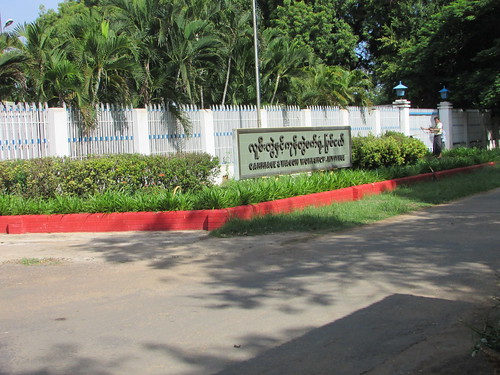
Myitnge Carriage and Wagon Workshop: Main entrance.
On arrival at the Carriage and Wagon Workshop, we parked outside the main entrance and, after a short meeting with the General Manager, we started a walking tour of the extensive workshops, built by the British.
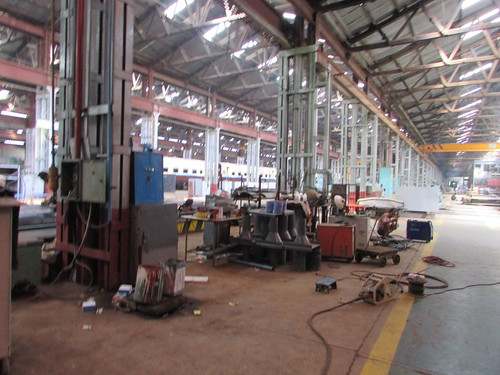
Myitnge Carriage and Wagon Workshop: General view of carriage workshop.
Each production area was neatly laid out, with painted walkways and carefully signed (in English) showing the work carried out. We looked and both major repairs to coaches and New Construction of existing designs. I found it most impressive.
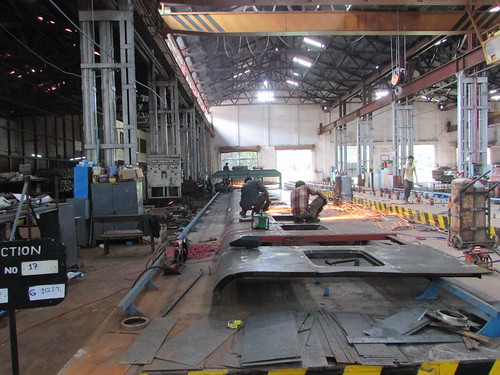
Myitnge Carriage and Wagon Workshop: Welded sides for new coaches being fabricated.
However, in an effort to improve levels of passenger comfort, Myanmar has concluded an agreement with China regarding a 'Concession Factory' to construct large numbers of new coaches of Chinese design. I toured the huge new steel-framed industrial buildings being provided for this project. These buildings are in an advanced stage of construction and production of the new coaches, using air suspension to give better ride characteristics, is expected to start in 2018.
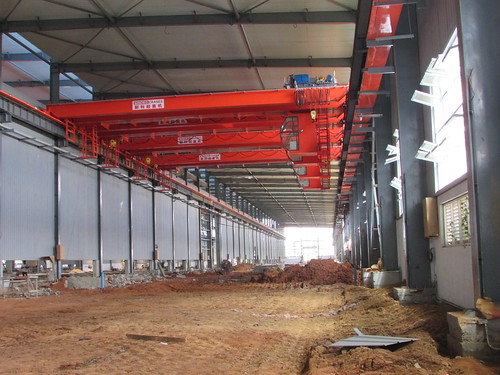
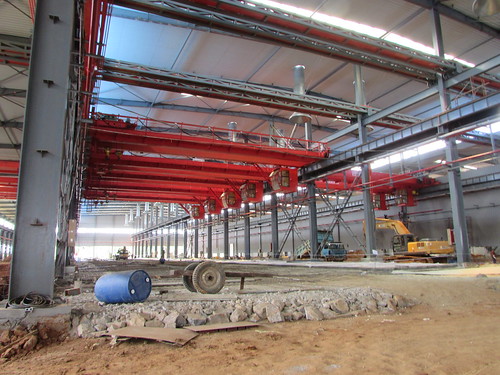
Myitnge Carriage and Wagon Workshop: New factory for producing coaches with air-suspension.
Following the tour of the new factory, we visited Htein Lin's Parents at their home in Myitnge.
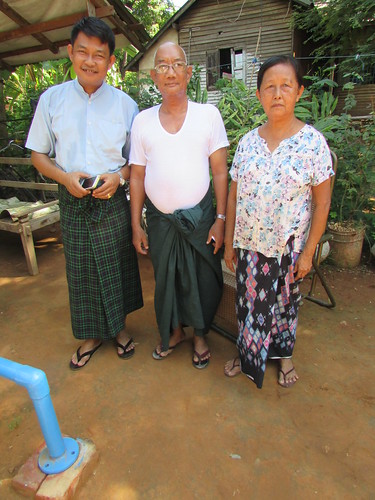
Htein Lin and his Parents.
Nearby, we met up with Htein Lin's family at a relative's home in Myitnge, where I had an excellent lunch exactly to my rather limited taste in Myanmar food.
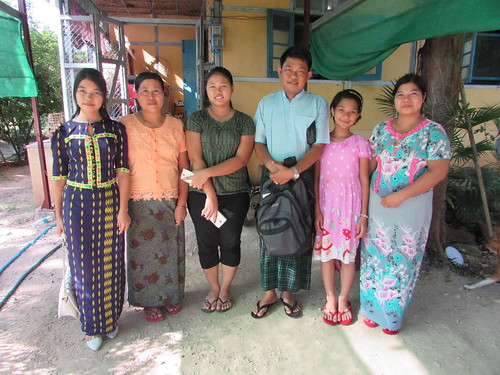
Htein Lin and Family at Myitnge.
We then went to see a modern pagoda which, unusually, is completely clad in jade of various shades of green.
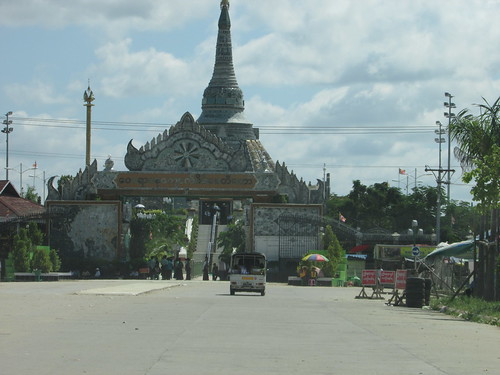
Mandalay district in 2017: The Jade Pagoda.
Ywa Taung is not far from Myitnge (although on the opposite side of the Ayeyarwaddy River). In 1975, Myanma Railways opened a diesel locomotive repair workshop there to supplement the capacity at Insein Works in Yangon. I was in Mandalay in 2015 as described here. I was unable to visit the works on that occasion because of an official holiday but visited the home of one of the managers and produced an article Ywa Taung Locomotive Workshop based on information I was given during that visit.
In 2017, I still didn't get to visit the works because the manager was away but I was able to make a social visit to his home.
It was agreed that I'd return to Mandalay by train from Ywa Taung station, allowing the car to take the family back to Myitnge but then my friend decided to accompany me on the train so he sent his family directly to Myitnge by car.
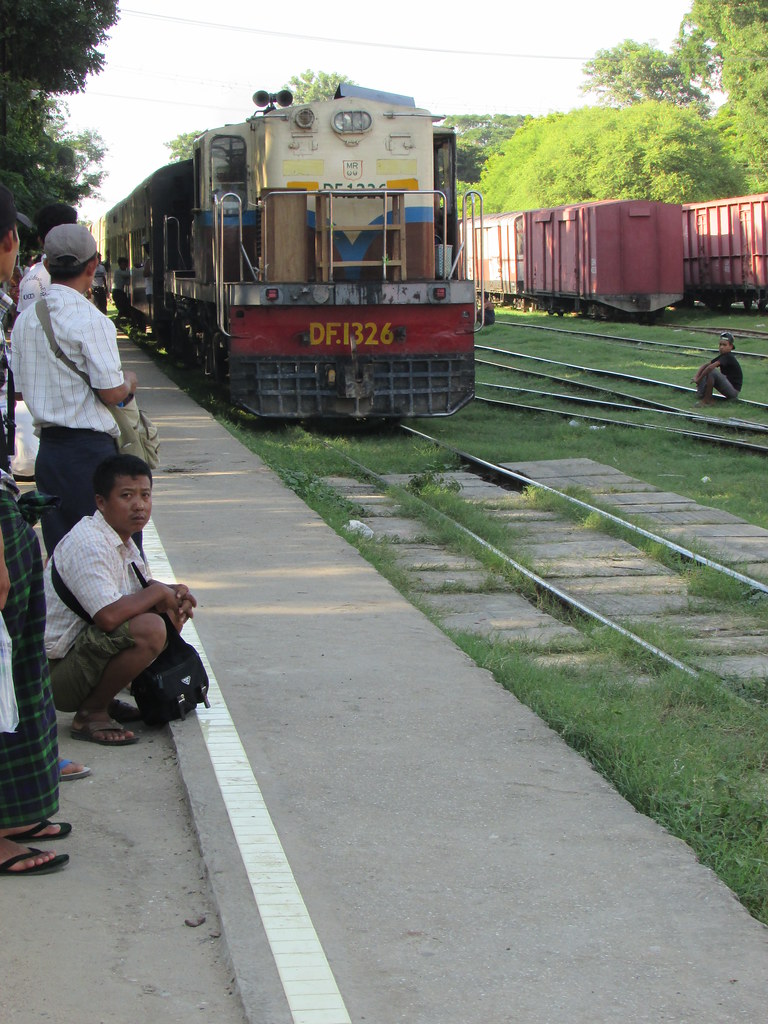
MR: Ywa Taung Station - DF.1326 arrives with the Up Myitkyina train on which I travelled to Mandalay.
After an interesting journey to Mandalay Station which took around an hour, we engaged two taxis - one to return my friend to Myitnge, a second to take me back to the Rupar Mandalar Hotel.
Related posts on this website
This is one of a series of posts describing my 12th visit to Myanmar. The post Starting out is the first post in the series.
Clicking on the 'Next report' link displays the post describing the next events. In this way, you may read about the trip in sequence.
Next report on this trip
Alternately, clicking on the 'All my Burma-2017(2) reports' link displays all the posts on this trip in reverse date-of-posting order.
All my Burma-2017(2) reports.
My photograph albums
Where necessary, clicking on an image above will display an 'uncropped' view or, alternately, pictures from may be selected, viewed or downloaded, in various sizes, from the albums listed:-
Rupar Mandalar Hotel.
MR: Myitnge Carriage and Wagon Workshop.
Family & Friends out & about.
Mandalay District.
MR: Ywa Taung - Mandalay.
[Amended 16-Oct-2017: Picture links added 17-Oct-2017: Minor edits, pictures added 08-Jan-2018]
Events of Monday 9th October 2017
I had all sorts of brave ideas about what I'd achieve on Monday but a combination of fatigue, difficulty in making firm arrangements, a backlog of e-mails to deal with and the desire to post at least brief trip reports on what had been going on meant that I settled for remaining in the comfort of my room at the Rupar Mandalar Hotel working on my laptop computer. I still felt tired at the end of the day but somewhat revived.
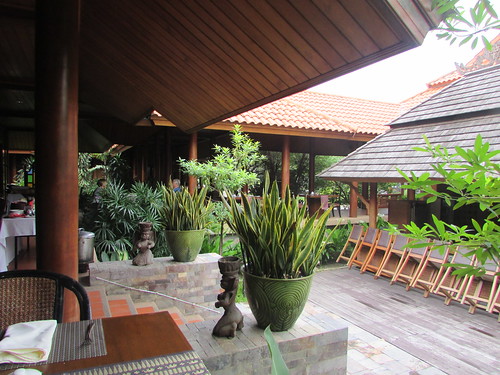
Rupar Mandalar Hotel: The Terrace where breakfast may be taken
Related posts on this website
This is one of a series of posts describing my 12th visit to Myanmar. The post Starting out is the first post in the series.
Clicking on the 'Next report' link displays the post describing the next events. In this way, you may read about the trip in sequence.
Next report on this trip.
Alternately, clicking on the 'All my Burma-2017(2) reports' link displays all the posts on this trip in reverse date-of-posting order.
All my Burma-2017(2) reports.
My photograph albums
Where necessary, clicking on an image above will display an 'uncropped' view or, alternately, pictures may be selected, viewed or downloaded, in various sizes, from the album listed:-
Rupar Mandalar Hotel.
[Links and picture added 8-Jan-2018]
On Wednesday, 11th October 2017 I boarded the 'Road to Mandalay' ship for its cruise to Bagan. This gave me the opportunity to update statistics on the work of the clinic.
My previous report showed monthly statistics up to the end of December, 2016, when the total number of treatments since the Clinic opened on August 6, 2011 was 190,030.
Treatment Summary
The table below shows the number of treatments per month from January 2017 to September 2017 and the new total number of treatments. The numbers should be regarded as provisional until finally confirmed.
| Month |
Treatments in month |
Total treatments |
| January 2017 |
2,198 |
192,228 |
| February 2017 |
1,704 |
193,932 |
| March 2017 |
2,010 |
195,942 |
| April 2017 |
1,326 |
197,268 |
| May 2017 |
1,985 |
179,346 |
| June 2017 |
2,261 |
199,529 |
| July 2017 |
2,639 |
202,168 |
| August 2017 |
2,511 |
204,679 |
| September 2017 |
2,666 |
207,345 |
Bagan Medical Clinic Opening
The Bagan Medical Clinic is open throughout the year except for one or two weeks during April because of the Water Festival and Myanmar New Year.
Doctor Hla Tun is also Chief Medical Officer aboard the 'Road to Mandalay' river cruise ship operated by Belmond. During much of the season, this ship shuttles between Shwe Kyet Yet (near Mandalay) and Bagan, mooring at Bagan (close to the Bagan Clinic) from Friday to Monday, whilst the ship's guests explore the wonders of the pagodas spread across the Bagan Plain. This allows Doctor Hla Tun to open the Bagan Clinic on Friday, Saturday and part of Sunday. Doctor Hla Tun typically sees 90 patients each day the Clinic is open. Less complex cases are seen by two other doctors.
Free Lunches
A free lunch is served to patients and their companions on the clinic days (Friday, Saturday, Sunday).
Other reports on medical support in Myanmar
There are a number of posts in this Blog describing medical support in Myanmar provided by the RTM Social Contribution with help from donors around the world. You can find them all here.
Photographs
There's a collection of pictures showing the Bagan Clinic from its inception here.
Doctor Hla Tun's photographs showing the work of the Bagan Clinic can be accessed by the following links:-
2014
2015
2016
Events of Sunday 8th October 2017
After my brief visit to the Indawgyi Lake area, on Sunday we were to retrace our outward route back to Myitkyina and, from there, catch a flight back to Mandalay.
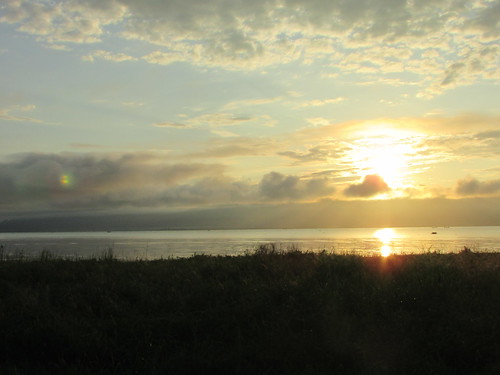
Lonton - Mandalay by road and air: Sunrise over Indawgyi Lake, viewed from IndawMaHar Guest House.
At around 6.30 a.m., July and I walked to a different tea shop where, again, Shan Noodle Soup was on offer. But, this time, mine was prepared without chicken and was delicious.

Lonton - Mandalay by road and air: Tea Shop in Lonton.
Everything was loaded into the 'Pajero' 4x4 and we set off across the plain, negotiated the twisting, spectacular road ascending Nantmoon Mountain and then continued on the descending section on the other side of the mountain range back to the fertile plain.
At Hopin, we stopped at the railway station. Initially, the Station Master was adamant that photography was not allowed, but, with the help of the book of pictures I'd brought highlighting some of my adventures in Myanmar, July quickly convinced him and then photography anywhere was possible.
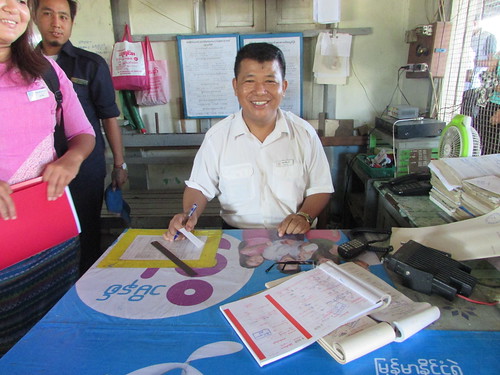
MR: Hopin Station Master.
After a short, useful photographic survey, we continued our journey, passing a long procession of motor cycles and lorries sporting the colourful Buddhist flag and crammed with pilgrims. These people were all involved in a tour of local pagodas, celebrating the end of the Buddhist Lent and, I imagine, fundraising.
We interrupted our onward travel with short stops for picture-taking at a level crossing and then Mingon station. Near the station, July chatted to a lady squatting in a ditch at the side of the road washing clothes on a concrete slab next to a small water cistern made from a section of wide concrete pipe set on end. The cistern could be filled from a plastic pipe with the usual plastic tap at the end. The water, the lady explained, came from Nantmoon Mountain and was very soft.
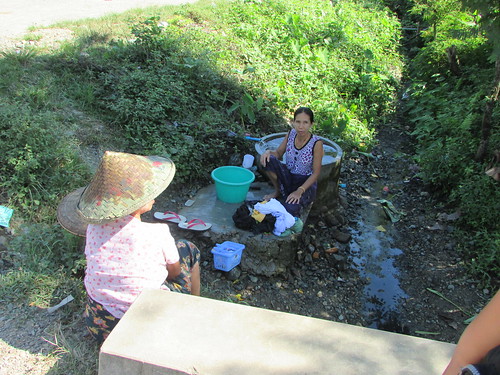
Lonton - Mandalay by road and air: Ladies doing laundry at Mingon.
We were back in Myitkyina by about half past twelve and had lunch at a modern restaurant very popular with young people and University students. It was clean, bright and included a small cocktail bar! Stylistically and culturally it was very different from the tea shops I'd become used to, but the food was good, inexpensive and the broad menu allowed me to have fish and chips.
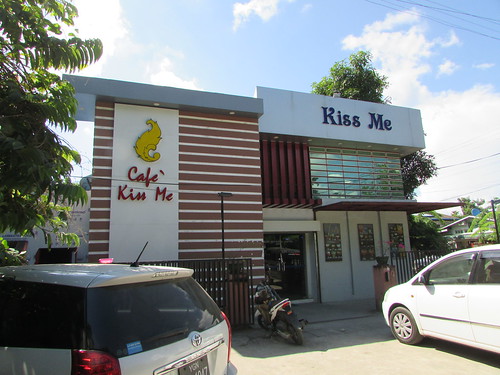
Lonton - Mandalay by road and air: Cafe Kiss Me, Myitkyina.
Next, we went to visit a Weaving Shed with five hand looms producing the materials for ladies longyi (the simple 'skirt' still widely worn). Because it was Sunday, the weavers were not at work but a lady from the owning family worked on an elaborate pattern including a gold-coloured thread to demonstrate just how labour intensive this type of weaving is. A good weaver can produce one longyi a day, for which they are paid 3,000 Kyat (roughly 3 U.S. dollars). Needless to say, by the time that longyi is retailed, the sale price is considerably higher.
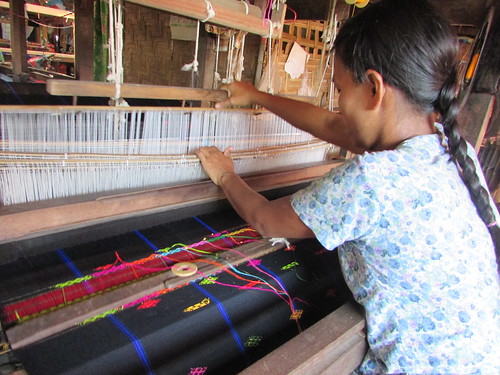
Weaving Factory, Myitkyina: Using a hand loom to produce a complex pattern.
There were also three children (two aged 8, one of 10) working on ancient electric machines loading the various coloured threads onto shuttles, ready for the weaving to continue. In Europe, such practices would fall foul of both safety and employment of children legislation, but these young people seemed perfectly happy as they went about their tasks.
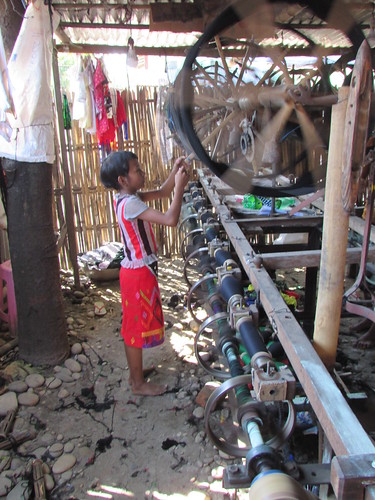
Weaving Factory, Myitkyina: An 8-year old girl dextrously loading shuttles with thread, in bare feet on a earth and pebble floor.
Just around the corner, we came to a larger weaving shed containing 15 power looms producing men's longyi, all working and making a loud clamour. The machines were from the Hirano company in Japan and most of the operators here were men. The generally simpler patterns typically found in men's longyi were better suited to power loom weaving.
Our car then took us to the airport at Myitkyina, where we said 'good bye' to our driver. July and I checked in for the KBZ afternoon flight to Mandalay. The aircraft was almost on time and our journey to Mandalay took about 75 minutes. Our luggage arrived safely and a car met us (with a driver who'd transferred me before). It took about an hour to get to my hotel, the Rupar Mandalar, where I was to stay for a few days. Here, I said 'good bye' to July and then collapsed in the comfort of my well-equipped room.
Related posts on other websites
There's a useful description of the Indawgyi Lake area on the Go-Myanmar site here.
Related posts on this website
This is one of a series of posts describing my 12th visit to Myanmar. The post Starting out is the first post in the series.
Clicking on the 'Next report' link displays the post describing the next events. In this way, you may read about the trip in sequence.
Next report
Alternately, clicking on the 'All my Burma-2017(2) reports' link displays all the posts on this trip in reverse date-of-posting order.
All my Burma-2017(2) reports.
My photograph albums
Lonton - Mandalay by Road and Air.
MR: Hopin.
MR: Mingon.
Weaving Factory, Myitkyina.
[Minor changes, pictures added to test 07-Jan-2018]
Events of Saturday 7th October 2017 continued
In the post Around Indawgyi Lake (part 1) I described the first part of my boat trip around Indawgyi Lake, up to our arrival at Nyaung Bin just after 3.00 p.m.
The main shopping area was formed of terraces of small shops, goods displayed across the raised floor fronting the dirt street, protected by awnings supported on bamboo poles. As usual, the range of goods on offer was extensive. The small cheroots and clay dish candleholders I saw were probably locally made but most manufactured items, from wellingtons to children's toys, were imported from China.
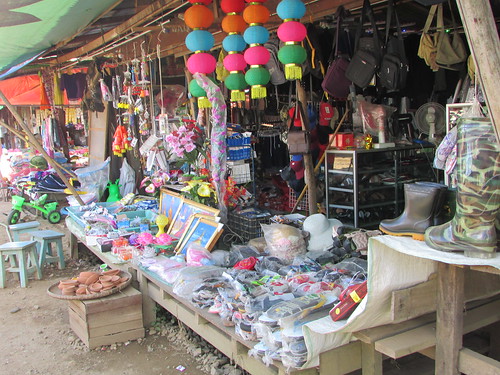
Indawgyi Lake (part 2): Shopping centre, Nyaung Bin.
Part of the village was formed from a number of fenced compounds. One compound we entered had a wooden house in good condition built on short stilts with a rusting galvanised iron roof, fronted by a small garden with potted plants and a grassed area. The rest of the space was taken up by a store room, kitchen area, simpler open sided living accommodation, a pig pen with four large pigs and a rather basic toilet.

Indawgyi Lake (part 2): House, garden and outbuildings in Nyaung Bin.
In one compound, July spotted a lady making white posies of flowers which she thought would be appropriate for our later visit to Shwe Myitzu Pagoda. She purchased two posies and we chatted to the lady, a mother of six children, for a minute or two.
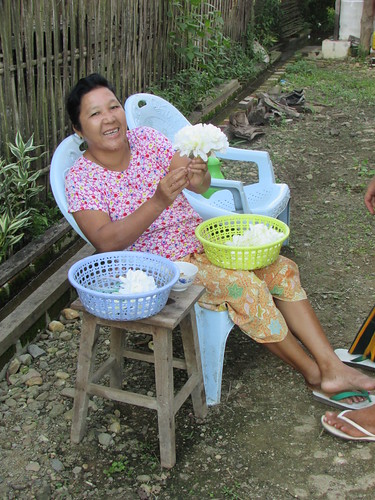
Indawgyi Lake (part 2): Lady making posies, Nyaung Bin.
Opposite, four children were playing a spinning top game. I gather it's common throughout Myanmar, but I don't remember seeing it before. In the traditional form we saw here, the coned top is wooden but I'm told you can nowadays you can get moulded plastic ones. A cord is wrapped around a smaller-diameter almost parallel sided top section allowed the top to be spun at sufficient speed for it to balance on its pointed end whilst the opponent attempts to topple it by throwing a projectile.
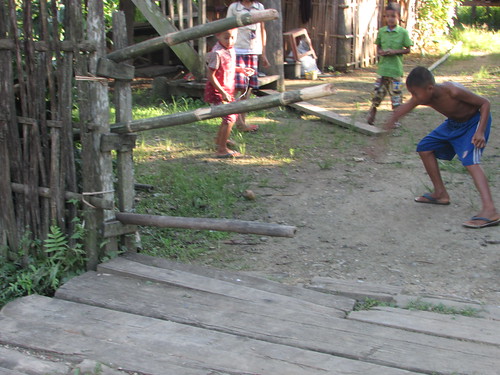
Indawgyi Lake (part 2): Children playing with a spinning top in Nyaung Bin.
We returned to our waiting boat and our boatman poled our transport astern into clear water before shattering the village calm by cranking the engine into life. We headed south then south west, throwing up impressive spray from the engine-cooling water discharge, passing a number of fishermen in smaller boats either man-powered or provided with a smaller engine driving a simple propeller via a 'long-tail' drive shaft. We passed the village of Lwemun close to the shore, where we watched the evening ritual of ablutions and clothes washing. The many children in the water seemed to be enjoying the fun to be had.
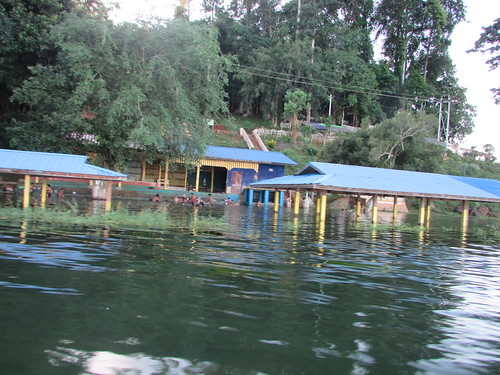
Indawgyi Lake (part 2): Lwemun, the evening ritual of ablutions and clothes washing.
Our southerly heading was now taking us to Shwe Mykitzu Pagoda, surrounded by the lake because we were visiting in the rainy season and twinkling in the evening sun like a golden ship. At the north-eastern corner of the solid pagoda platform, an ante-room standing on wooden piles and covered by a galvanised iron roof had been constructed. This ante-room was connected to the pagoda platform by a diagonal gangplank.
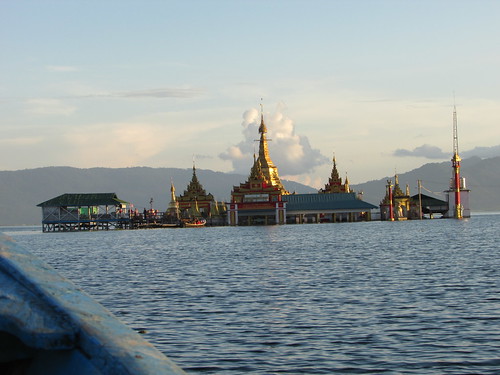
Shwe Mykitzu Pagoda, Indawgyi Lake, Myanmar. The covered ante-room and landing stage is on the left.
A wooden landing stage extending west from the ante-chamber with steps down to the water allowed boats to land and embark pilgrims.
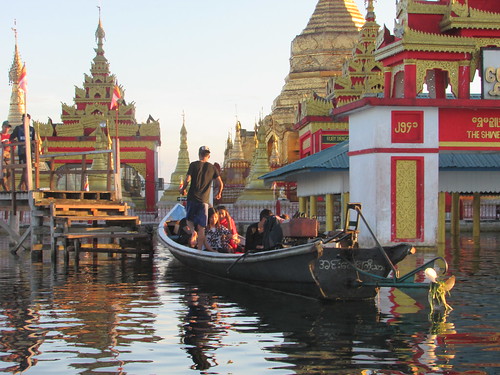
Shwe Mykitzu Pagoda, Indawgyi Lake, Myanmar: A group of pilgrims about to leave the landing stage by boat. Note the weed on the raised propeller.
Male pilgrims can transfer from the ante-room to the pagoda platform using the gangplank, in order to pay their respects. However, ladies are not allowed on the pagoda platform so female pilgrims must (and males may) pay their respects from the covered ante-chamber. July walked along the gangplank to hail a man already on the pagoda platform, asking him to place her white posies of flowers at the shrine, which he did.
Because of the time of year, there was a raft moored to the eastern side of the pagoda platform which carried a large, three-dimensional armature covered in scales made from bands of shiny coloured paper of various colours representing a fish but I didn't discover the significance of this custom.
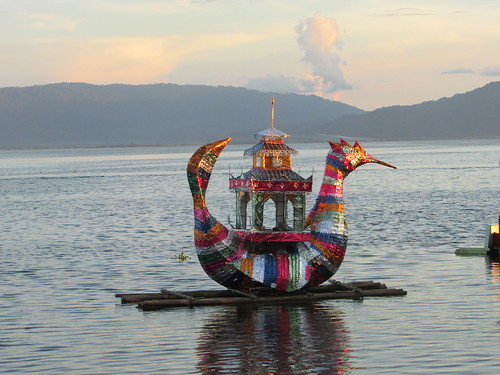
Shwe Mykitzu Pagoda, Indawgyi Lake, Myanmar: 'Fish' Raft.
Looking down into the water from the ante-chamber, I could see the decorated tiling of the lower pagoda platform which would become exposed in the dry season. To the west, the setting sun provided a colourful backdrop to a very special pagoda.
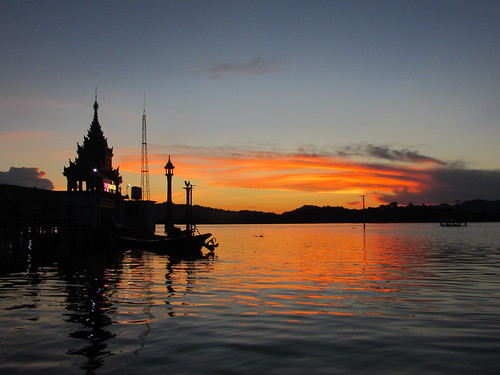
Sunset at Shwe Mykitzu Pagoda, Indawgyi Lake, Myanmar.
Our boat then completed the journey back to Lonton and, having said 'good-bye' to the boatman, July and I walked the short distance to the Guest House. Tired after the exertions of the day, I backed-up the pictures I'd made, took a cold shower and went to bed.
Related posts on other websites
There's a useful description of the Indawgyi Lake area on the Go-Myanmar site here.
Related posts on this website
This is one of a series of posts describing my 12th visit to Myanmar. The post Starting out is the first post in the series.
Clicking on the 'Next report' link displays the post describing the next events. In this way, you may read about the trip in sequence.
Next report
Alternately, clicking on the 'All my Burma-2017(2) reports' link displays all the posts on this trip in reverse date-of-posting order.
All my Burma-2017(2) reports.
My photographs
Where necessary, clicking on an image above will display an 'uncropped' view or, alternately, pictures may be selected, viewed or downloaded, in various sizes, from the album listed:-
Indawgyi Lake (part 2)
[Revised, links added 03/01/2018: Minor changes, pictures added to test 07/01/2018]
Events of Saturday 7th October 2017
Indawgyi Lake is the largest lake in Myanmar and one of the largest in South-East Asia, about 8 miles wide and 15 miles North to South with 20 villages (mainly Shan or Kachin) around the shore. Its isolated location means that it is unspoiled and it has been designated a UNESCO Biosphere Reserve. The best-known feature of the lake is probably the Shwe Myitzu Pagoda, actually built in the lake and accessible by causeway during the dry season but requiring a boat trip when I visited
I’d slept well on the raised but hard bed at the IndawMaHar Guest House which is built on piles at the edge of the lake and stood about two feet above the lake level when I visited in the rainy season. Near the shore, green weed grows all around, so it wasn’t particularly obvious that you were over water until you used the short wooden 'gangplank' linking the main building to the separate wooden bathroom.
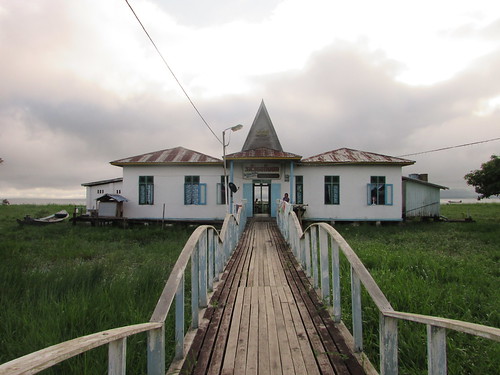
Indawgyi Lake (part 1): IndawMaHar Guest House.
At about 7.30 a.m., July and I walked across the road from our Guest House to a tea shop. We passed chickens foraging for food near the road outside one house whilst a large pig was stretched out in front of another, enjoying the early morning sun. We looked at a very overloaded motor cycle festooned with various bags. This, it transpired, was the mobile shop and the lady proprietor seemed to be doing reasonable business.
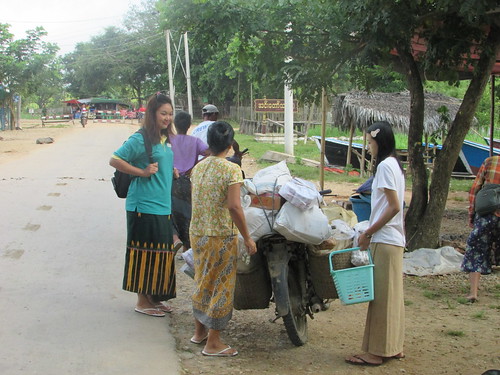
Indawgyi Lake (part 1): Lonton, the Mobile Shop.
At the tea shop, the choices appeared to be Shan Noodle Soup or Shan Noodle Soup. Although I was assured that there were only vegetables in mine, I found generous lumps of chicken. But they managed a fairly cold Coca Cola.
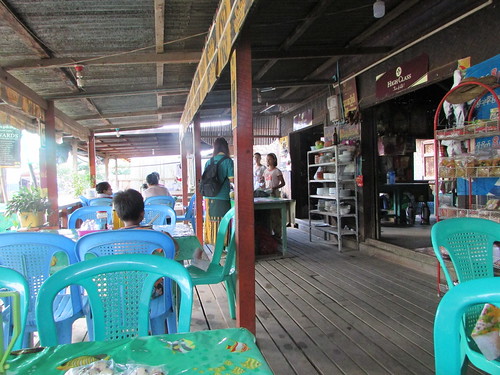
Indawgyi Lake (part 1): Breakfast at a tea shop in Lonton.
Having finished our breakfast, we walked back to the Guest House, where a young girl was perched on one of the wooden walkways next to the building washing clothes, using a stick to beat water through the fibres of the fabric.
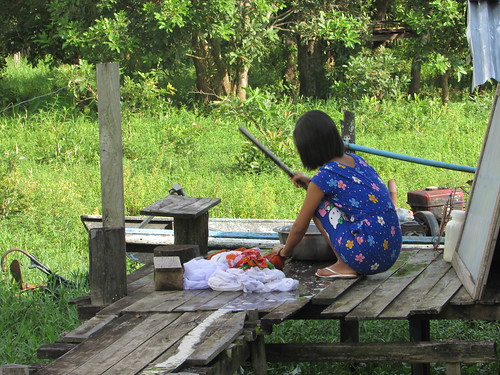
Indawgyi Lake (part 1): Laundry work at IndawMaHar Guest House.
Having collected what we needed for the day, July and I walked the few yards to the Inn Chit Tha Building. Inn Chit Tha are a local not-for-profit eco-tourism group set up in 2013. Their office was crammed with bicycles for hire but we’d booked a boat trip. Alongside the Inn Chit Tha building there was a small creek, filled with weed and motor boats similar in design to those used on Inle lake. A rickety single-plank wide gangway ran along one side. This appeared to be what served as the Jetty. A boatman was putting diesel in one of the engines and then he pushed the boat to a position where we could board. July and I were both equipped with lifejackets (which we discarded later in the day as being hot and uncomfortable – I saw no other person wearing one during the day). When we were aboard, the boatman extricated our craft from the weeds and the adjacent boats by a combination of pulling against the other boats and, once there was space to insert his long bamboo pole, poling.
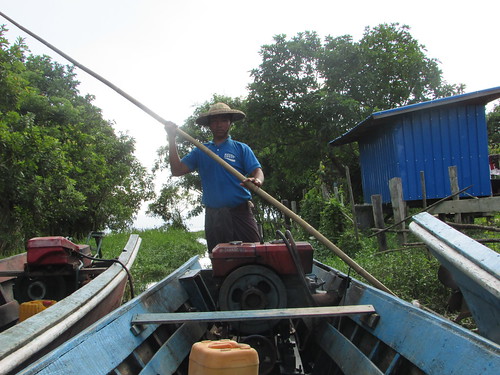
Indawgyi Lake (part 1): Leaving Lonton by boat.
The motive power was the usual sort of Chinese-made single-cylinder diesel engine developing around 25 horse power which required hand-cranking to start. Whatever exhaust system has once been provided, it was long gone, and the engine block discharged directly upwards producing a noise that was, to say the least, raucous.
At about 9.00 a.m. we left Lonton, which is fairly near the southern end of Lake Indawgyi on the west shore. We headed slightly east of north at a good speed. I expected us to call at the Shwe Myitzu Pagoda, shimmering in the sun but we kept going and July explained that our destination was to be a series of pagodas at Shwe Taung built on Golden Mountain. This is near the northern end of the lake towards the east, where the Indawgyi River discharges into the lake.
So it was around 10.00 a.m. when we arrived at the foot of Golden Mountain where a steep, sandy hillside sloped into the water near a painted Buddha image next to a building housing a shrine. A herd of mountain buffalo were ambling across the hillside, apparently making for the water. There seemed to be no facilities for landing – the boatman simply pointed the prow at the bank and cut the engine. Scrambling ashore was easier than expected, but the buffalo were still on the track leading to the Buddha image.
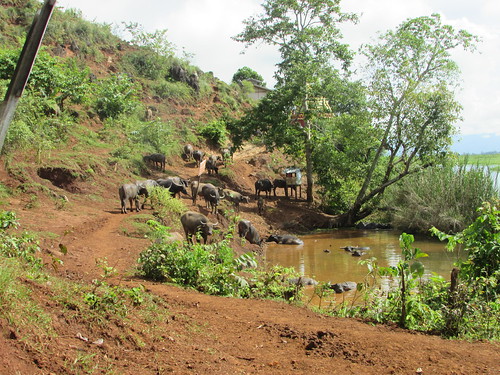
Indawgyi Lake (part 1): Mountain buffalo at Golden Mountain).
Buffalo are very watchful creatures and their apparently intelligent eyes hold you in their gaze. Despite their size and strength, they are easily spooked by any sudden movement. Even when they are almost completely submerged in water, their eyes remain focused on you. I was reminded of the similar behaviour of hippopotamus I’d seen in Africa (mantioned in the post Savuti (2)).
From near the Buddha image, a way led up the hill to the first pagoda. I say ‘way’: it was more a trench cut by water now (mostly) dry, rather than a track, probably very suitable for mountain buffalo but not ideal for wobbly elderly foreigners. I set off well enough but on a tricky bend I lost my balance and fell on my backside. I only suffered minor abrasions on one arm and loss of what little dignity remains but I’d found a spot that was still a little muddy. You would have hoped I’d have learnt my lesson on Nightingale Island (for more details see my post Nightingale and Inaccessible Islands). July was horrified but, of course, I elected to carry on, with welcome help from July on subsequent tricky corners. But by the time we reached the first pagoda, the heat and the exertion had 'winded' me. Near the pagoda was a building with a shrine and a single young monk in residence. He was quite happy for me to sit in the shade of his building whilst July checked out an alternative route.
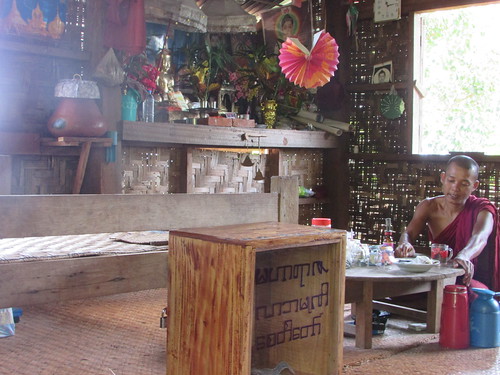
Indawgyi Lake (part 1): The young monk on Golden Mountain.
I must have happily rested there for three quarters of an hour and meanwhile July reported that carrying on uphill through woodland to the monastery would offer an alternative, perhaps easier, way down. Well, I agreed but the rest didn't seem to have restored me much and, even with July's willing help, I was stopping frequently for a 'breather', although the track through the woods appeared not that hard. I was quite pleased when our boatman joined us and, with the combined help of July and the boatman, I completed the climb to the monastery. We sat on seats overlooking the lake and I was surprised at our elevation. Later, July presented me with a bowl of apple slices which I slowly ate and enjoyed. Then we went into the monastery where the head monk said foreigners often sleep there and, offering a blanket and pillow,invited me to sleep. There were two cats nearby, also resting, so I followed their example and lay, perfectly content, for almost an hour. Although my visit didn't work out quite as planned, I'd had a really special time on Golden Mountain.
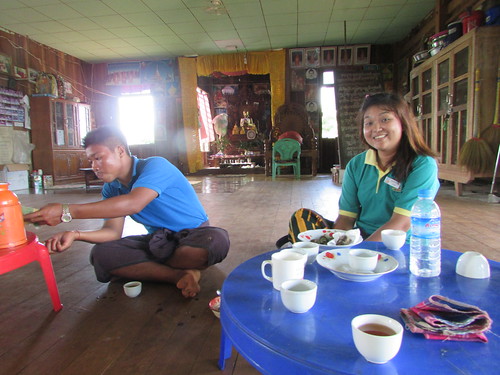
Indawgyi Lake (part 1): With our boatman and July, relaxing in the monastery on Golden Mountain.
We'd had the offer from the monk of a motor bike ride for me downhill to the alternative landing place and I was all in favour but July wouldn't countenance it until she'd done it herself to assess risk which involved her going down and back to rejoin me. Even then, it was only reluctantly that she let the young driver bring me down. The track was certainly steep and with some tricky spots but I enjoyed the run and we were soon back on our boat and underway for the short transit to Nyaung Bin.
Related posts on other websites
There's a useful description of the Indawgyi Lake area on the Go-Myanmar site here.
Related posts on this website
This is one of a series of posts describing my 12th visit to Myanmar. The post Starting out is the first post in the series.
Clicking on the 'Next report' link displays the post describing the next events. In this way, you may read about the trip in sequence.
Next report on this trip.
Alternately, clicking on the 'All my Burma-2017(2) reports' link displays all the posts on this trip in reverse date-of-posting order.
All my Burma-2017(2) reports.
My photograph albums
Where necessary, clicking on an image above will display an 'uncropped' view or, alternately, pictures may be selected, viewed or downloaded, in various sizes, from the albums listed:-
Indawgyi Lake (part 1).
[Link to pictures added, 16-Oct-2017: Pictures added 4-Jan-2018]
Events of Friday 6th October 2017
I started the day at the Palm Spring Resort Hotel in Myitkyina with a walk around the well-tended gardens fronting on the river then took breakfast in the large dining room. They opened at seven and clearly concentrated on providing for the Myanmar guests first – there was a range of Myanmar dishes, coffee and chilled water already laid out. Orange juice arrived a little later and a toaster for the white sliced bread much later. Despite the language problems, I managed to get two fried eggs, 'sunny side'.
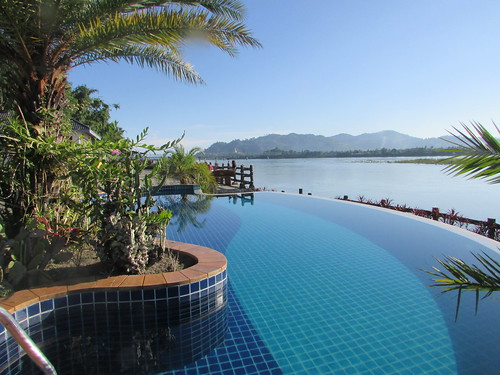
Palm Springs Resort, Myitkyina.
On the previous day, I'd carefully explained to July my interest in railways so our first destination was the railway station. To my surprise, there was a train waiting to depart - the 8.00 a.m. to Mandalay headed by a sparkling reconditioned YDM4 "with fuel-efficient engine" only recently arrived in Myanmar. I took pictures as the crowded train left then studied other features of the track and signalling equipment before locating the Station Master. The Station Master's Office usually has a track diagram of the station and, once July explained my interest, he was happy to let me take pictures.
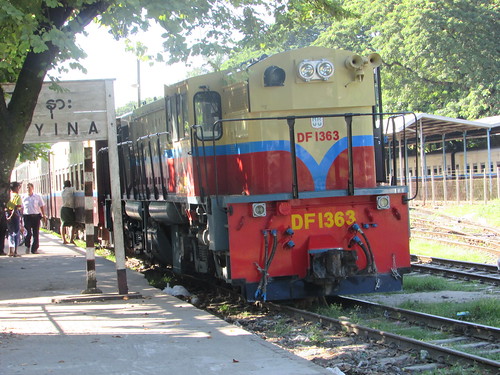
MR: Myitkyina: DF 1363 ready to depart for Mandalay.
Having discovered that there was a State Museum in Myitkyina, I was keen to visit it (although it was not on my pre-arranged programme). We agreed to see if it was open although that seemed unlikely since the day was what they call a 'Gazetted Holiday' (presumably a legacy of British Rule). The main gates were closed but July walked in through a side gate to make enquiries and before long returned to beckon the car in. By the time we'd driven round the building to the parking area, the front door of the modern building was being opened so I was able to spend a pleasant hour in the well-presented museum.
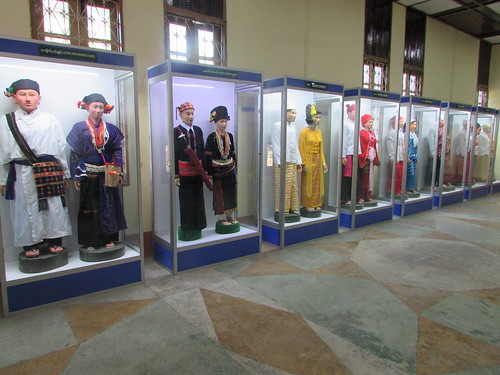
Kachin State Museum, Myitkyina: Display of ethnic costumes.
At a level crossing leaving the city, I spotted a nice example of a lattice post outer home signal so we stopped for pictures. The signal was 'off' and a couple of minutes later a long passenger train rumbled past, at the end of its journey to Myitkyina.
We then continued south with a slight delay at the roadside immigration desk when the officer couldn't find the entry stamp in my passport. July sorted it out and we carried on to Mogaung where we stopped for lunch at a Chinese-style restaurant, served by a young boy waiter about ten years old (but going on 28). The meal was accompanied by a xylophone and drum band in a three-wheel motor cycle taxi parked outside the restaurant, apparently connected with celebrations at a monastery along the side street. Their music didn't seem terribly good and was punctuated by celebratory firecrackers. These were periodically set off by a young lad in the taxi who each time, having lit and tossed the firework, covered both ears with his hands.
Before leaving Mogaung, we paid a brief visit to the station where, again, the Station master let me take pictures. He was clearly amused that I understood the principles of trapped key interlocking as he followed my simplified explanations to July.
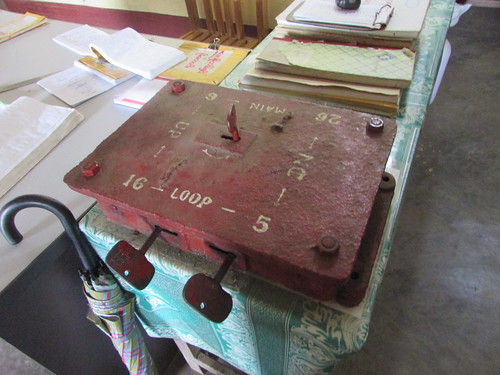
MR: Mogaung: Trapped Key locking box.
We carried on to Hopin and here we made a pleasant visit to July's sister's and her three children.
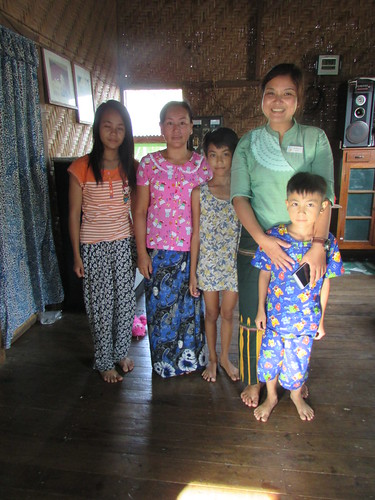
Hopin: July with her Sister and Children.
Leaving Hopin, our route took us high into the mountains on a winding, difficult road across Nantmoon Mountain. When we stopped at a viewpoint to look back at the plain we'd left, just where we'd parked there was a large patch of the fascinating Sensitive Plant whose fern-like leaves fold up in self-defence when touched. There's more about this plant on Wikipedia here.
A little further on we came to the summit, this time with a viewpoint showing the hair-raising descent we were about to undertake leading us down to the plain on the Indawgyi Lake side of the Nantmoon Mountain. A crowd of happy Myanmar tourists were taking pictures around the large sign, in Myanmar language and English, reading 'Indawgyi Biosphere Reserve'.
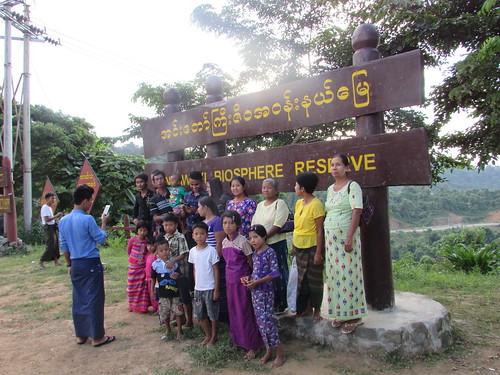
Myitkyina - Lonton by road: A photocall at the sign for Indawgyi Biosphere Reserve.
The ground fell away from the viewpoint quite steeply but a small herd of mountain buffalo traversed the steep hillside with remarkable assurance for their size. Our 4x4 descended safely around the twists and turns to the plain but it was best not to look too closely at just how deep the drop was at the side of the road.
Passing through Nawn Ting Village on the plain, we came across what was clearly important football match between two village teams - Natgyikhone and Latpansayt. There were hundreds of motor cycles parked, some passenger-carrying pick-up trucks and a good selection of traders selling food. What the players lacked in talent was more than compensated for by their enthusiasm and the spectators whooped and jumped up and down at every pass. We watched the last ten minutes of the game as I found the atmosphere infectious. The local mothers all seemed to carry their young babies on their backs in a simple cloth 'sling'. One woman spectator was so excited, jumping up and down and shouting, I was sure her baby would be ejected from the sling! At the final whistle, the result was a win for Latpansayt 2-1 , the pitch was invaded by spectators, and some players took off their shirts and threw them high into the air. After this entertainment, we continued our journey together with large numbers of motor cycles taking spectators home.
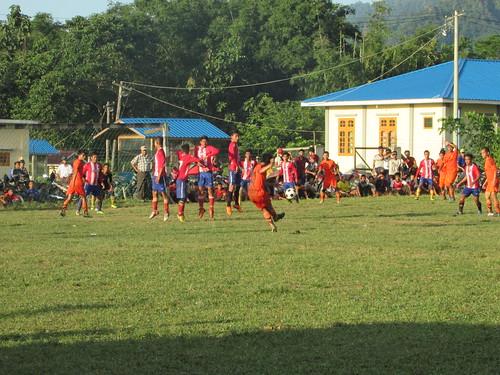
Myitkyina - Lonton by road: Natgyikhone playing Latpansayt.
Finally, we arrived at the lakeside village of Lonton and our Guest House for the night. The description I'd been given of 'Very Basic' was accurate but, after a cold shower in the shared-use wooden bathroom provided with a western-style water closet, I slept soundly.
I first published a brief trip report once I'd arrived back in Mandalay, but I'm afraid putting my pictures on 'Flickr' had to await a better internet connection back in Yangon. I didn't catch up with 'embedding' a few pictures until January, 2018.
Related posts on this website
This is one of a series of posts describing my 12th visit to Myanmar. The post Starting out is the first post in the series.
Clicking on the 'Next report' link displays the post describing the next events. In this way, you may read about the trip in sequence.
Next report on this trip.
Alternately, clicking on the 'All my Burma-2017(2) reports' link displays all the posts on this trip in reverse date-of-posting order.
All my Burma-2017(2) reports.
My photograph albums
Where necessary, clicking on an image above will display an 'uncropped' view or, alternately, pictures may be selected, viewed or downloaded, in various sizes, from the albums listed:-
Palm Springs Resort, Myitkyina.
Kachin State Museum, Myitkyina.
Myitkyina - Lonton by road.
MR: Myitkyina.
MR: Mogaung.
[Minor changes and links to pictures added 16-Oct-2017: Pictures added 4-Jan-2018]
Events of Thursday 5th October 2017
It was raining again when I got up. Google insisted on telling me the outside temperature (though I hadn’t asked). Only two trains passed below me as I took breakfast in the Horizon Club Lounge, then I returned to my room to work on the computer and complete my final packing. Having checked-out, I was picked up on time for my transfer to the smart new domestic terminal at Mingalardon Airport.
All luggage and possessions have to be X-Rayed and passengers have to pass through a Metal Detector Arch and are then scanned by a hand-held ‘wand’. There are two low boxes on the floor which you are asked to stand on, one for men, one for women. A lady officer checks the female passengers, a man the male passengers. You are asked to hold your arms out sideways, so that they can check underarms. On my little podium, I felt like an orchestra conductor about to launch the music. But the Burmese are always so polite and smiling, it’s the one place I don’t get ‘rattled’ by security. KBZ, the airline I was flying with to Myitkyina, have introduced a Common Check-in for all flights where you can wait in any queue you choose. I chose what looked like the shortest queue but got it wrong. A young Western couple ahead of me with two young children who, as I waited in the queue, proved to be rather disobedient had brought an amazing amount of luggage which kept appearing a case at a time. Their check-in required the attention of about six airline staff. I don’t know whether they really were moving house, but they could have been. Then my queue was down to one innocent looking young Burmese girl who suddenly flashed seven passports. With horror, I realised that she was the guide with a group of seven European tourists I’d spotted nonchalantly chatting a little way off. Eventually, it was my turn and check-in was completed with the customary smiling courtesy. An escalator took me to the departure hall where, since my last trip, they have introduced a second security station to X-ray carry-on baggage and repeat the passenger checks, just like at the entrance to the building. There are now glossy shops for pastry, various café options (including a KFC!) and up-market watches.
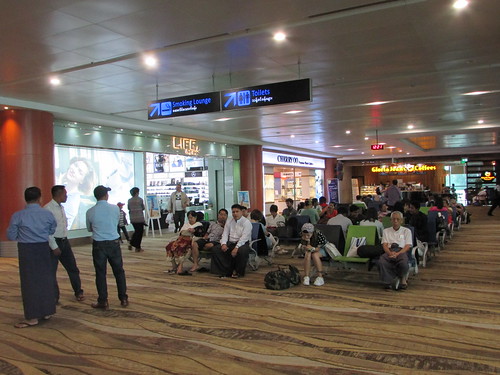
Yangon, flying to Myitkyina.
My flight was called and I hurried to Boarding Gate 32. As I expected, the rather smart Airbridge discharged us onto metal stairs leading to a transfer bus. Fortunately, the stairs had been provided with a roof, for it was still raining hard. Although the bus had parked close to the exit from the stairs, a smiling man from the airline was ready with a large umbrella to protect passengers from the rain and this process was repeated when we reached the aircraft and had to board the ATR 72-500/600 via its ‘Airstairs’. We did some high speed taxiing and were airborne just after 1.00 p.m., climbing to 18,000 feet for our journey of about an hour and a quarter to our first stop at Mandalay International Airport. Mandalay passengers were collected by a transfer bus whilst a large fuel bowser topped up our fuel.
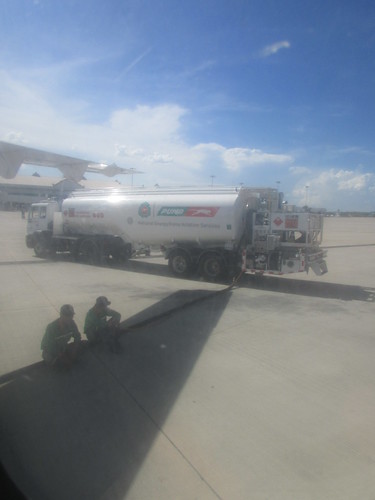
Yangon-Myitkyina: As we re-fuel at Mandalay, the ground crew shelter from the sun in the wing's shadow.
I knew that my lady guide from Mandalay would board the flight and I spotted her as soon as she came on board and introductions were quickly made. Her name is July Win. The flight was not full so she was able to sit next to me for the Mandalay to Myitkyina ‘leg’.
On arrival at Myitkyina, the local Agent had also turned up to make sure everything had worked out. Immigration logged my entry into Kachin state whilst we waited for my checked bag to arrive, then I met the local driver and the Mitsubishi 4x4 'Pajero' provided for the trip.
First we went to the Reclining Buddha Image. On the second day of the holiday, it was crowded with pilgrims and volunteers were handing out plastic glasses of orange juice containing small pieces of black jelly.
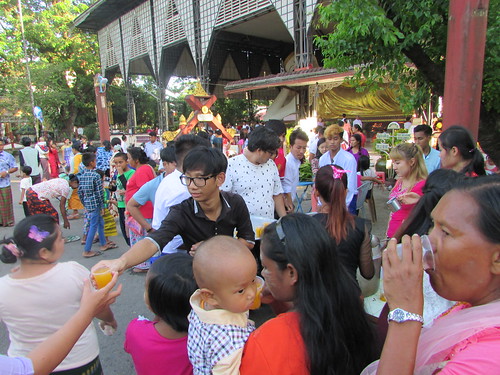
Myitkyina Reclining Buddha: Volunteers were handing out plastic glasses of orange juice containing small pieces of black jelly.
We then walked across to the associated pagoda, undergoing repairs, where more volunteers were laying out 1,000 clay candle holders for the Festival of Light Ceremony that evening. We next looked an astrology stall, where the result is already written in cards laid on a table. The correct card is selected from tossing seven small shells combined with your Birth Sign (there are 8 in Myanmar Astrology). Whilst we waited for our car to pick us up, I tried rice cakes, fried over a fire of wooden sticks.
Myitkyina is the capital of Kachin State which is home, I think, to 25 ethnic minorities so we visited the National Playground where ethnic ceremonies are performed.
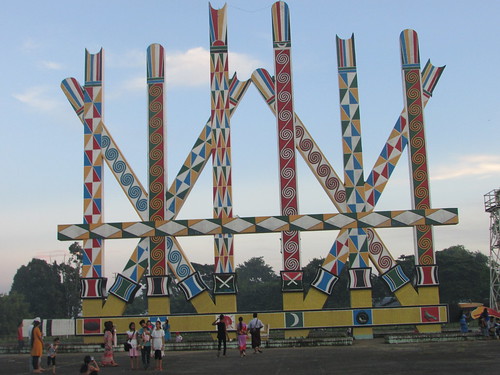
Kachin State National Playground, Myitkyina.
By the time we reached the Palm Spring Resort Hotel, it was dark. I’d been given room 2001 on the first floor at the head of a very grand wooden staircase.
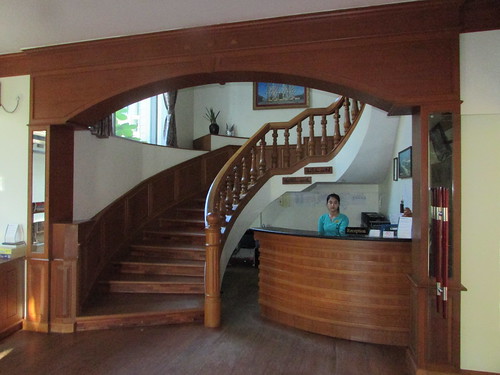
Palm Springs Resort, Myitkyina.
The room was very well-appointed and, although there was supposed to be Wi-Fi, I didn’t succeed in connecting to either of the routers my computer detected. I explored the grounds in the dark, found the dining room but decided I’d enough food with me for the evening so returned to my room, worked on the computer a little and then slept well in the large bed although the mattress was rather hard.
Related posts on this website
This is one of a series of posts describing my 12th visit to Myanmar. The post Starting out is the first post in the series.
Clicking on the 'Next report' link displays the post describing the next events. In this way, you may read about the trip in sequence.
Next report on this trip.
Alternately, clicking on the 'All my Burma-2017(2) reports' link displays all the posts on this trip in reverse date-of-posting order.
All my Burma-2017(2) reports.
My photograph albums
Where necessary, clicking on an image above will display an 'uncropped' view or, alternately, pictures may be selected, viewed or downloaded, in various sizes, from the albums listed:-
Yangon around and about.
Sule Shangri-La Hotel, Yangon.
Yangon Airport (This and earlier trips).
Yangon to Myitkyina by Air.
Myitkyina, around and about.
Palm Springs Resort, Myitkyina.
[Links to albums added, 16-Oct-2017: Pictures added 4-Jan-2018]






















































